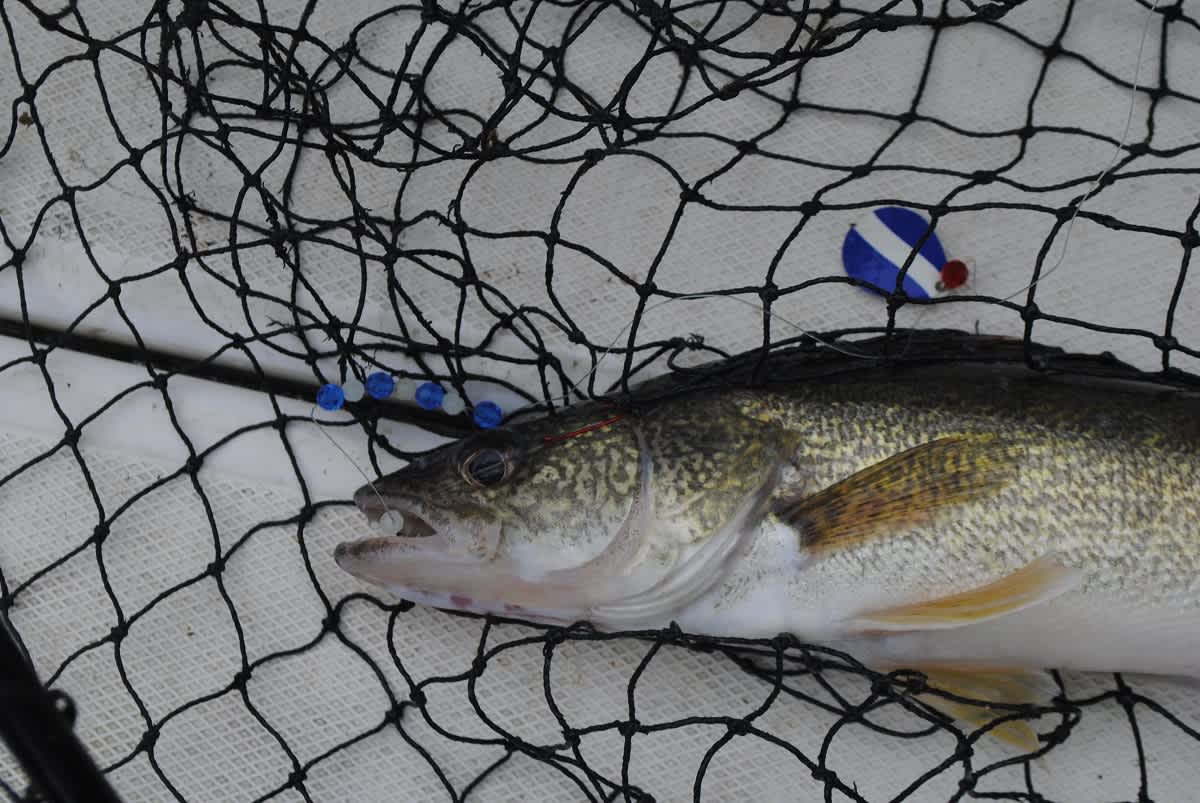Crawlers and Bottom-bouncers for Saginaw Bay Walleye
Bob Gwizdz 06.05.14

Saginaw Bay might not have been exactly angry, but the ol’ gal had a little bit of an attitude. The ride on Brandon Stanton’s 30-foot center console was bumpy enough that he decided maybe we should just set lines and troll out to where we were going, rather than fight the waves.
More than an hour later, when we reached the 14-foot hole Stanton had targeted, one of the rods began bouncing in its holder. I grabbed it and we were in the plus column.
Stanton, who guides walleye anglers on open water and through the ice on Saginaw Bay, had invited me to join him and his brother-in-law, Stacy Jarson, for a May morning that started out cold and windy but eventually became what a May Michigan day is supposed to be. And the fish cooperated, too.
The pair started with six rods, four with planer boards dragging body baits, and two with bottom bouncers and nightcrawler harnesses. After our first three fish (two keepers and a throwback) on came the crawlers, and the guys began swapping out terminal tackle, using bottom-bouncers or snap weights on the boards to get the crawler harnesses down.

Pairing the two baits (crawlers on harnesses and floating/diving plugs) on the same troll is something Stanton started doing this year.
“Usually it’s one or the other,” said Stanton, who was trying to keep his rig, powered by twin 225-horse outboards, at 1.3 miles an hour. “It’s hard to fish both baits at once. You have to troll the crawlers so slowly that you don’t get the action you want out of the body baits.”
For the most part, we were catching the exact walleyes you’d want for the table, 17 to 20 inches, with about an equal number that were either larger or smaller. Of the smaller ones, most were right about that 15-inch (legal size) mark, either just over or just under.
“The bigger fish are still out in deeper water,” said Stanton, who worked 14- to 17-foot depths, which, he says, is pretty typical for early season walleyes on the Bay. “They’ll be coming back in soon as the water warms up and they’ll get in the weed beds. They’ll stay in the weeds until it gets hot, then they’ll head out to deep water.”
Stanton, who has been fishing the Bay his entire life (his dad was a walleye fisherman), began guiding a few years ago as he was going to be out fishing anyway and he figured it could help with his expenses. He’s been pretty successful at it; this winter, he took ice-fishing parties out 32 days in a row.
The Saginaw Bay walleye fishery has changed dramatically over the years, Stanton said.
“The last 10 or 15 years, the size of the fish has gone down quite a bit, but the numbers have skyrocketed,” he said. “When I was a kid, you’d go walleye fishing and if you caught two fish, you had a good day. But those two fish would weigh 20 to 30 pounds. Now you go out and catch 30 fish, but they’ll all go 17 to 20 inches.
“If you look at the tournament results, you can see how the big fish have gone down over the years. The big fish used to 13 or 14 pounds. Now, if you catch a seven-pounder, you’ve got a pretty good fish. A seven to eight-pound walleye will win big fish in any tournament here in the summer.”
This is a pretty typical phenomenon for developing fisheries. Early on, when the population is low, the growth rates are astronomical. But as the population increases, the growth rate declines. That’s where Saginaw Bay is right now.
It’s where Lake Erie was when the walleye population exploded there a couple of decades ago. You would load the boat with keepers; fact is, there were so many walleyes on Erie that for a while the Department of Natural Resources lowered the length limit to 13 inches. These days, the numbers aren’t there in Erie like they were, but the fish are bigger.

What goes around comes around.
Despite marking fish high in the water column (fish that are typically active and are usually targeted by anglers), we were catching ours near the bottom.
“It’s a bottom bite today,” Stanton said. “But we’ve been marking so many so many fish high up in the water column that we have to keep trying for them.”
After we had 10 fish in the box, all taken on or near bottom on crawlers, we finally caught a fish on a body bait. But even then it was on a deep-diving Reef Runner that had clay on its bill when we reeled it in.
The next fish came on a crawler, too.
Because I had an afternoon appointment, I called the day early. We had 12 in the box and had tossed back five undersized ‘eyes. Stanton was disappointed we hadn’t boxed a limit (that was on me for quitting early, though I was completely satisfied with our results). Stanton offered that if we’d have gritted our teeth and taken the pounding instead of wasting the time on the shallow troll, the extra hour of fishing might have made the difference.
Hindsight, eh?
Stanton offered to take me again to show me. I don’t need convincing.
“They’re tracking those tagged fish all the way up to Alpena in the summer,” he said. “They come back to the Bay in winter, spawn, and then head back out to deep water.
“But this fishing in here should be good through the end of June.”
For more information on Michigan fishing go to michigan.org. Click here to purchase a Michigan fishing license online.
This article was produced in partnership with Pure Michigan.

